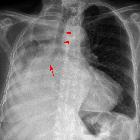Large-cell lung cancer

Large-cell lung cancer is one of the histological types of non-small-cell carcinomas of the lung diagnosed only on resection, after exclusion of adenocarcinomatous or squamous differentiation.
Epidemiology
It is thought to account for approximately 10% of bronchogenic carcinoma .
Clinical presentation
Patients present with dyspnea, chronic cough, and hemoptysis.
Pathology
Microscopically large cell carcinoma is characterized by large nuclei/nucleoli with a moderate amount of cytoplasm, hence the name large cell carcinoma. This undifferentiated tumor lacks distinctive features of small cell carcinoma, glandular, or squamous differentiation.
According to the last international consensus, the diagnosis of large cell carcinoma should not be achieved based on small biopsy or cytology samples and is, therefore, restricted to resection specimens where the tumor is completely sampled to exclude a differentiated component .
On immunophenotyping, characteristic features include :
- loss of staining with CK5/6
- CK14 positive in most squamous cell carcinoma (SCC)
- lack of MOC 31 positive in most adenocarcinomas
- positive immunoreactivity to EGFR, PDGFR-alpha and c-kit.
The subtype large cell neuroendocrine carcinoma is now grouped under the pulmonary neuroendocrine tumors since the last WHO review in 2015 .
Radiographic features
Large-cell lung cancer of the lung typically presents as a large peripheral mass of solid attenuation and irregular margin. Focal necrosis can be present. Other characteristics include rapid growth and early metastasis.
Treatment and prognosis
The histologic subtype of large cell neuroendocrine tumor has a more aggressive pattern and is associated with poorer prognosis.
Siehe auch:
und weiter:

 Assoziationen und Differentialdiagnosen zu large cell carcinoma of the lung:
Assoziationen und Differentialdiagnosen zu large cell carcinoma of the lung:
